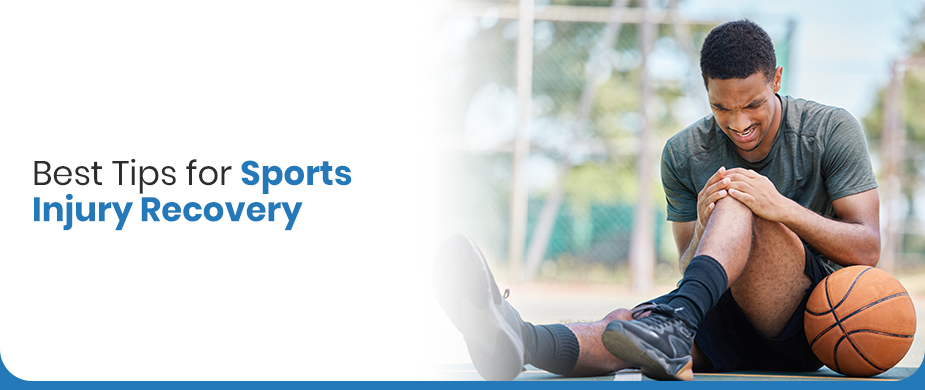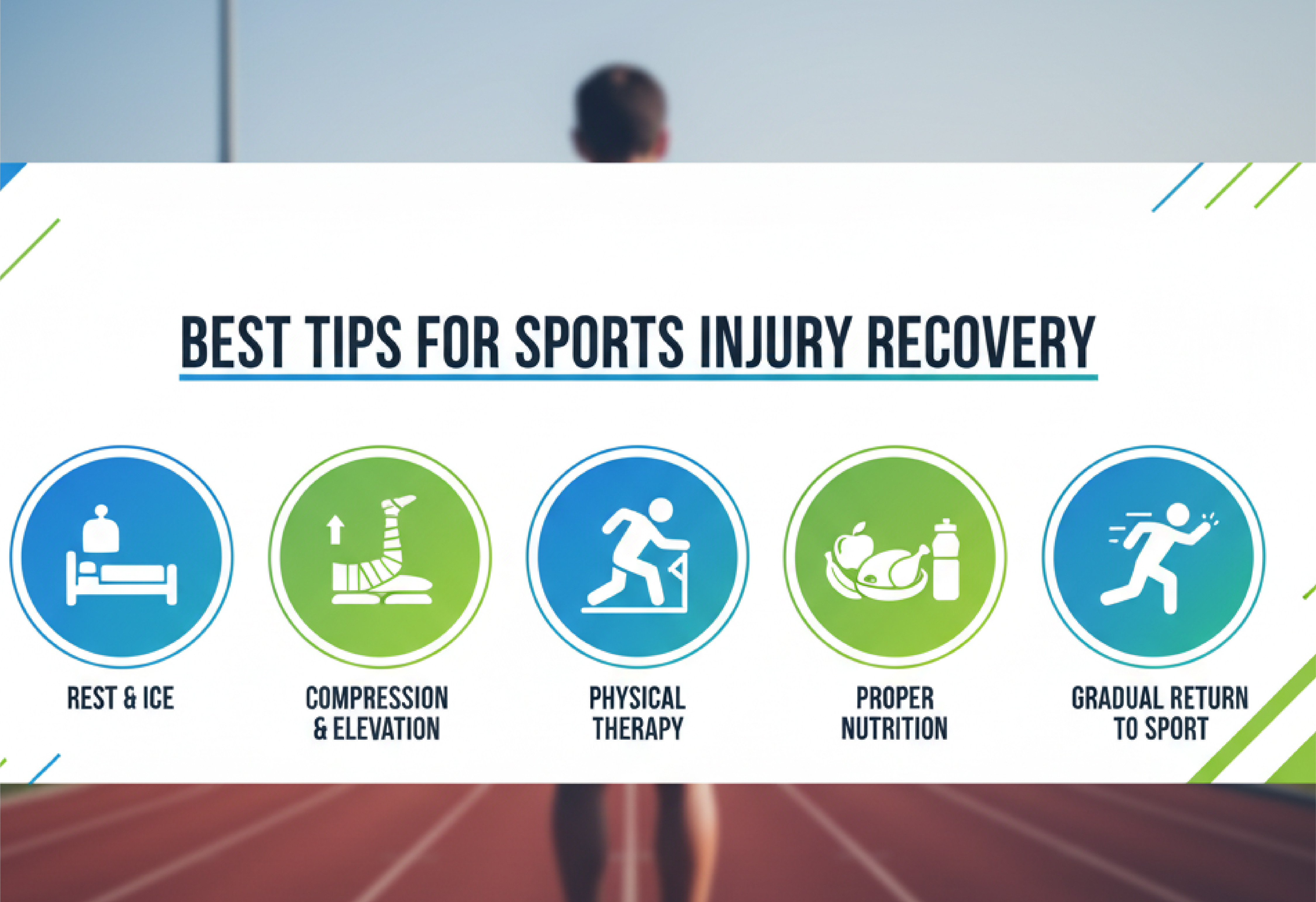
Book an Appointment
Call Us01140846835Best Tips for Sports Injury Recovery
Sport is such a big part of growing up; we all cherish those matches, practice sessions, the thrill of winning, and the anger of losing. But as life moves on, not everyone keeps on playing or takes sports as a career. Some lose interest, some choose different careers, and others have to quit because of injuries or the fear of getting hurt. But hey, don’t let that fear take away your love for your favorite sports.
Getting injured doesn’t mean it’s the end; recovery is part of learning or mastering the game, too. The key is to take it slow, listen to your body, and never ignore your doctor’s advice, especially for serious injuries. With the right care, physiotherapy rehabilitation, rest, healing methods, sleep, and patience, you can get back stronger than before. Never forget, healing takes time, but passion keeps you going.
Health Note: If you notice pain, swelling, bruising, bone fractures, dislocations, or concussions, seek medical advice from a licensed healthcare professional. This article provides general information on sports injury tips and is not intended to replace expert advice.

How to Recover from Sports Injuries | The Tips
The tips depend on the severity of the sports injury (minor or major injury). Let's explore their tips separately.
A. Tips to Recover from Minor Sports Injuries
1. Guard the Injured Area
Avoid stress or weight on the injured area, allowing it to heal. You can also use supports like braces if required to prevent further damage.
2. Apply Ice to the Wounded Area
Apply ice packs for 15-20 minutes every few hours during the first 48 hours after injury. This helps reduce swelling and pain.
Note: Always wrap the ice with a clean cloth to protect the skin.
3. Compression & Elevation of Injured Area
Cover the injured area with a compression bandage. Elevate the injured ankle, knee, elbow, or wrist above heart level to reduce swelling and increase fluid drainage from the injury site.
Note: Do not wrap the injured area so tightly that it cuts off the circulation.
4. Slow Gentle Motions
Once pain and swelling diminish, start slow stretching and mobility exercises. This helps prevent stiffness of the joint and promotes circulation without overtaxing the injury site.
5. Rehabilitation Techniques
Follow a guided physical therapy plan, like the IBS Hospital sports recovery plan focused on restoring strength and flexibility around the injury. This supports full functional recovery and reduces re-injury risk.
6. Balanced Diet
Eat an adequate amount of protein and anti-inflammatory nutrients. This supports tissue repair and decreases chronic inflammation for faster healing.
7. Avoid Rushing Back to Sports Activity
Do not rush back into full sports activity. Take it slow and increase intensity under professional advice, allowing the injury to fully heal and preventing re-injury.
8. Take Medical Advice if Needed
Pay attention to any worrying signs like worsening pain, swelling, instability, or numbness. And consult a healthcare professional ASAP to rule out any serious complications.
Treatment of minor injuries includes using the R-I-C-E method to relieve pain and inflammation and to speed healing.
- R- Rest
- I- Ice
- C- Compression
- E- Elevation
Other treatments under a doctor's guidance may include over-the-counter anti-inflammatory medications and, rarely, medications that can reduce pain and swelling.
B. Tips to Recover from Major Sports Injuries
Major sports injuries require professional treatment, and some of their methods are:
1. Immobilization
In case of a major trauma, your doctor can recommend controlled immobilization to stabilize the injured structure. This prevents further tissue damage and allows repair by organizing fibrin and collagen deposition.
2. Surgery
If a sports injury leads to complete rupture of ligaments, tendons, or bones. The doctor may opt for surgical fixation or reconstruction to restore the function of the body part.
3. Rehabilitation
Rehabilitation is the crucial part of sports injury recovery. It starts with the P.O.L.I.C.E. principle:
- P: Protection
- O: Optimal Loading
- I: Ice
- C: Compression
- E: Elevation
This method is focused on early but graded movement to promote collagen reorganization and joint function.
Rehabilitation Of Sport Injury At IBS Hospital
Sports injury rehabilitation at IBS Hospital differs greatly from traditional methods:
- Have a multidisciplinary team of orthopaedics, sports medicine, physiotherapy, and neurorehabilitation experts.
- Equipped with advanced tools like robotic-assisted therapy, magnetic and electrical stimulation, and motion analysis machines.
- The plan comprises biomechanical and functional outcome assessments to track muscle balance, motion range, etc.
- The IBS integrated model rebuilds communication between the nervous system and injured muscles.
- The plan is designed for sport-specific retraining sessions to rebuild strength, endurance, and flexibility.
Conclusion
Most sports injuries can be addressed by proper treatment and rehabilitation, helping you to return to normal activities. All you need is to seek help promptly and follow your doctor's advice at the IBS Hospital.
According to the National Institutes of Health (NIH), early interventions and ongoing multidisciplinary care significantly improve outcomes for people with sports injuries.
About IBS Hospital
This article was prepared by the IBS Hospital Neurology and Rehabilitation Team, a trusted healthcare provider with over 15 years of experience in diagnosing and managing neurological conditions. Every article is medically reviewed to ensure reliability and clinical accuracy.
FAQs
Q1: Who Treats Sports Injuries?
Sports injuries are treated by:
- orthopedic surgeons
- sports medicine specialists
- physiotherapists
Sports injuries are generally initially seen and treated by emergency physicians, who care for patients in emergency rooms (for serious injuries). But many hospitals, like IBS Hospital, have multidisciplinary teams working together to diagnose, repair, and rehabilitate damaged muscles, ligaments, or bones for optimal recovery.
Q2: How long does a sports injury take to heal?
It depends on whether the injury is mild or serious. Mild sprains and strains generally heal within 1–3 weeks. But ligament tears, fractures, or severe tissue injuries may take 3–12 months.
Q3: How to recover from an injury faster?
Faster sport injury recovery depends on:
- early diagnosis
- adequate rest
- graded physiotherapy
- balanced nutrition
- adherence to doctors' guidance, like the R.I.C.E. or P.O.L.I.C.E. principles that minimize inflammation and promote tissue repair.
 By -Dr Aaksha Shukla |
October 24, 2025 | 9 Min Read
By -Dr Aaksha Shukla |
October 24, 2025 | 9 Min Read
How Deep Brain Stimulation (DBS) Helps in Parkinson’s & Tremor Control
Early Warning Signs of a Brain Tumour & When to See a Neurosurgeon
Signs of a Stroke: When to Seek Emergency Neuro Care
Best Neurosurgery Hospitals in Delhi NCR: A Detailed Guide
Minimally Invasive Spine Surgery: Benefits, Cost & Recovery
Guide to Stroke Prevention and Recovery
How to Manage Parkinson’s Symptoms Effectively
Traumatic Brain Injury: Symptoms, Causes, and Treatments
10 Superfoods That Boost Your Brain Power
10 Early Warning Signs of Brain Stroke Everyone Should Know
5 Most Common Sports Injuries and Their Quick Treatments
12 Everyday Habits That Damage Your Spine
Brain Stroke: Causes, Warning Signs & Emergency Treatment
10 Early Symptoms of Brain Tumor You Should Never Ignore
How to Choose the Right Neurosurgeon in Delhi NCR
How Stress Affects Brain Health: Neurological Insights
Early Signs of Spinal Disorders in Working Professionals
How Advanced Neurosurgery Is Saving Lives: A Look Inside IBS Hospitals
Epilepsy: Diagnosis and Treatment in Delhi
Stroke Recovery: How a Comprehensive Neuro Rehab Plan Makes the Difference

